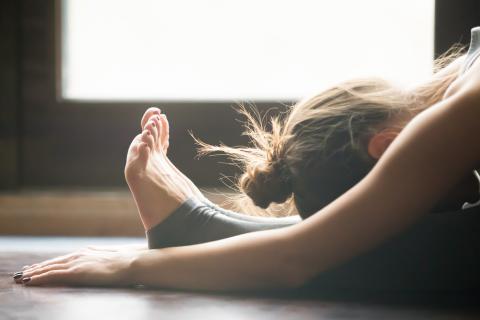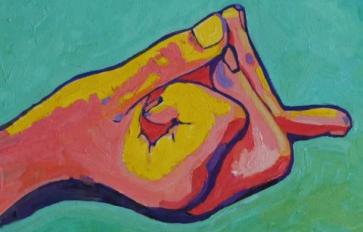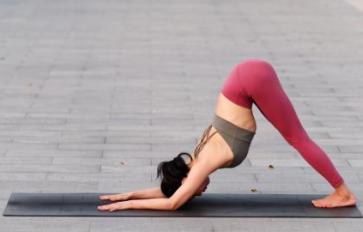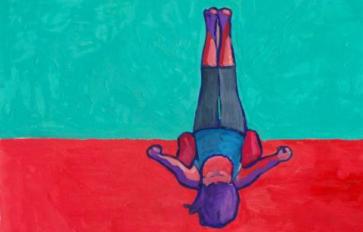
Just imagine: a style of yoga that can enable you to meditate with less joint pain while increasing your flexibility and deepening your connective tissue elasticity. I’m referring to the ancient Chinese Taoist origins of yin yoga and it can help you bring balance to your body and your yoga practice. Unlike more active styles of yoga like Vinyasa yoga or Kundalini yoga, yin yoga is a practice of stillness with a focus on inward awareness, which is why it can easily enhance your daily meditation. Practitioners of yin yoga hold positions that strengthen and lengthen their connective tissues while keeping their muscles almost entirely relaxed. This allows them to surrender to gravity and its slow, gentle pull on their connective tissues to increase their strength and elasticity throughout their practice.
Yin yoga is founded in the Taoist concepts of yin and yang as it relates to opposite yet complementary principals in nature. While yin often refers to the still, stable and often unseen aspects of life, yang is associated with the moving, changing, and revealing aspects that each connect to and reflect one another. When we apply this dualistic philosophy to our bodies, our yin qualities may be synonymous with our connective tissues (our hidden tendons, ligaments and fascia), while our forward moving muscles and blood flow may resemble our active, yang qualities. Therefore with this concept in mind, a practitioner of yin yoga honors this intention by bringing balance to one’s inner yin and yang qualities. Yin yoga classes may involve holding different types of yin poses for slightly longer periods of time than other styles of yoga. In fact, it's common practice for yin yoga practitioners to hold these postures in stillness for at least three to five minutes per posture.
But when it comes to practicing yin yoga, Bernie Clark artfully describes it in his book, The Complete Guide to Yin Yoga: the philosophy and practice of Yin Yoga. He writes, “consider your will and your body as two dancers, moving in total unison. Too many beginning and even experienced yoga students make their yoga into a wrestling match—the mind contending with the body, forcing it into postures that the body is resisting. Yoga is a dance, not a wrestling match.”
With that advice in mind, I urge newcomers to yin yoga to move into these new postures with ease, take variations when needed, and listen to your bodies. In every pose, you will meet your edge or your point of resistance and it's important to honor that point and not push yourself beyond it or you will risk injury. The following six yin yoga poses should be held for 3-5 minutes per posture. These postures can not only improve your joint mobility and flexibility, they can also strengthen your muscle fascia, increase your circulation and reduce stress and anxiety by calming the mind and body.
The Dragonfly Pose
Begin in a seated position on your yoga mat and spread your legs apart as wide as possible. Next, simply fold forward and rest your weight into your hands with your arms extended straight in front of you.
Variation: Half-Dragonfly Pose
Instead of spreading both of your legs apart at the same time, bend your right leg and pull your right foot close in toward your body and slowly bend at your waist and fold forward to hold the pose before switching sides.
Benefits: opens the hips, lower back, hamstrings, groin, back of thighs, and inner knees.
The Butterfly Pose
Start in a seated position on your yoga mat and bring the soles of your feet together. Next, gently slide your feet away from your body to form a diamond shape with your legs. Find roundness in your back; gently fold forward and allow your head to hang and your hands to reach toward your heels.
Variation: Lying Butterfly Pose
Instead of bending forward, keep the soles of your feet together and lie down comfortably on your back with your arms at your sides. If your hips or groin feel tight, you can always move your feet farther away from your body.
Benefits: releases tension in your neck, safely stretches your lower back, increases elasticity in your groin and its connective tissues, relieves menstrual and muscle cramps, and calms the mind.
The Caterpillar Pose
Begin in a seated position with your legs straight out in front of you. Then round your back and fold forward until you feel some resistance in the back of your knees as your hamstrings begin to contract and hold the position.
Variation: The Staff Pose
Instead of folding forward, sit upright in a seated position on your yoga mat with an elongated spine. Next, turn your shoulder blades toward each other and press your hands into your yoga mat at your side.
Benefits: lengthens the ligaments that run along the spine, activates the hamstrings, compresses the abdomen to aid in digestion, and calms the mind.
The Shoelace Pose
Begin with your legs extended out in front of you with a tall, erect spine. Next, bend your right knee and cross your foot over your left leg and heel toe your right foot over until you feel a slight straining sensation as your knees get closer together with one over the other. Stay upright or slowly fold forward to feel into the full position.
Variation: Eye of the Needle Pose
Lie on your back, bend your knees and place the soles of your feet flat on the floor. Next, bring your left, outer ankle to the outside of your right knee so your foot hovers in the air. Then flex your left foot, actively pressing through your heel while simultaneously pulling your toes back toward the left. Then switch sides.
Benefits: decompresses your lower spine; opens your outer hips, glutes, low back, and shoulders; improves circulation throughout your knees and legs; and aids in digestion.
The Frog Pose
Begin in child’s pose with your knees shoulder length apart on your yoga mat. Next, gently lift your hips to be aligned with your knees so that you feel a slight pull on your groin. When you’re ready and willing, place your chest and stomach on your yoga mat and extend your arms overhead to hold the frog pose.
Variation: The Tadpole Pose
If the pressure on your groin and inner thighs is too severe, you can hold the tadpole pose by bringing your toes to touch with your knees apart and then gently push your hips back and bend forward into the tadpole pose.
Benefits: opens your hip joints, chest, and shoulders; strengthens your back muscles; improves circulation in hips and thighs; increases the expansion of your lungs; aids digestion; releases stress-induced anxiety.








